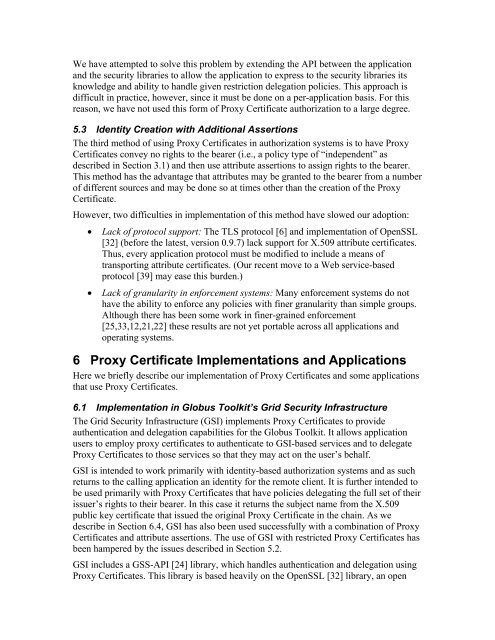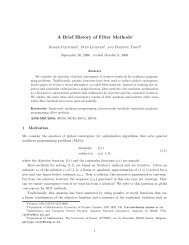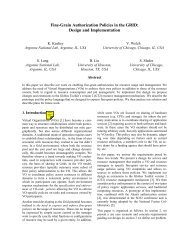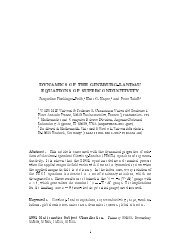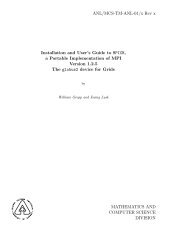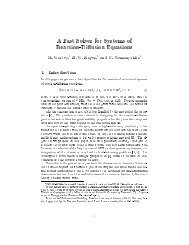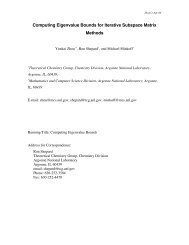X.509 Proxy Certificates for Dynamic Delegation - tp.mcs.anl.gov ...
X.509 Proxy Certificates for Dynamic Delegation - tp.mcs.anl.gov ...
X.509 Proxy Certificates for Dynamic Delegation - tp.mcs.anl.gov ...
Create successful ePaper yourself
Turn your PDF publications into a flip-book with our unique Google optimized e-Paper software.
We have attempted to solve this problem by extending the API between the applicationand the security libraries to allow the application to express to the security libraries itsknowledge and ability to handle given restriction delegation policies. This approach isdifficult in practice, however, since it must be done on a per-application basis. For thisreason, we have not used this <strong>for</strong>m of <strong>Proxy</strong> Certificate authorization to a large degree.5.3 Identity Creation with Additional AssertionsThe third method of using <strong>Proxy</strong> <strong>Certificates</strong> in authorization systems is to have <strong>Proxy</strong><strong>Certificates</strong> convey no rights to the bearer (i.e., a policy type of “independent” asdescribed in Section 3.1) and then use attribute assertions to assign rights to the bearer.This method has the advantage that attributes may be granted to the bearer from a numberof different sources and may be done so at times other than the creation of the <strong>Proxy</strong>Certificate.However, two difficulties in implementation of this method have slowed our adoption:• Lack of protocol support: The TLS protocol [6] and implementation of OpenSSL[32] (be<strong>for</strong>e the latest, version 0.9.7) lack support <strong>for</strong> <strong>X.509</strong> attribute certificates.Thus, every application protocol must be modified to include a means oftransporting attribute certificates. (Our recent move to a Web service-basedprotocol [39] may ease this burden.)• Lack of granularity in en<strong>for</strong>cement systems: Many en<strong>for</strong>cement systems do nothave the ability to en<strong>for</strong>ce any policies with finer granularity than simple groups.Although there has been some work in finer-grained en<strong>for</strong>cement[25,33,12,21,22] these results are not yet portable across all applications andoperating systems.6 <strong>Proxy</strong> Certificate Implementations and ApplicationsHere we briefly describe our implementation of <strong>Proxy</strong> <strong>Certificates</strong> and some applicationsthat use <strong>Proxy</strong> <strong>Certificates</strong>.6.1 Implementation in Globus Toolkit’s Grid Security InfrastructureThe Grid Security Infrastructure (GSI) implements <strong>Proxy</strong> <strong>Certificates</strong> to provideauthentication and delegation capabilities <strong>for</strong> the Globus Toolkit. It allows applicationusers to employ proxy certificates to authenticate to GSI-based services and to delegate<strong>Proxy</strong> <strong>Certificates</strong> to those services so that they may act on the user’s behalf.GSI is intended to work primarily with identity-based authorization systems and as suchreturns to the calling application an identity <strong>for</strong> the remote client. It is further intended tobe used primarily with <strong>Proxy</strong> <strong>Certificates</strong> that have policies delegating the full set of theirissuer’s rights to their bearer. In this case it returns the subject name from the <strong>X.509</strong>public key certificate that issued the original <strong>Proxy</strong> Certificate in the chain. As wedescribe in Section 6.4, GSI has also been used successfully with a combination of <strong>Proxy</strong><strong>Certificates</strong> and attribute assertions. The use of GSI with restricted <strong>Proxy</strong> <strong>Certificates</strong> hasbeen hampered by the issues described in Section 5.2.GSI includes a GSS-API [24] library, which handles authentication and delegation using<strong>Proxy</strong> <strong>Certificates</strong>. This library is based heavily on the OpenSSL [32] library, an open


